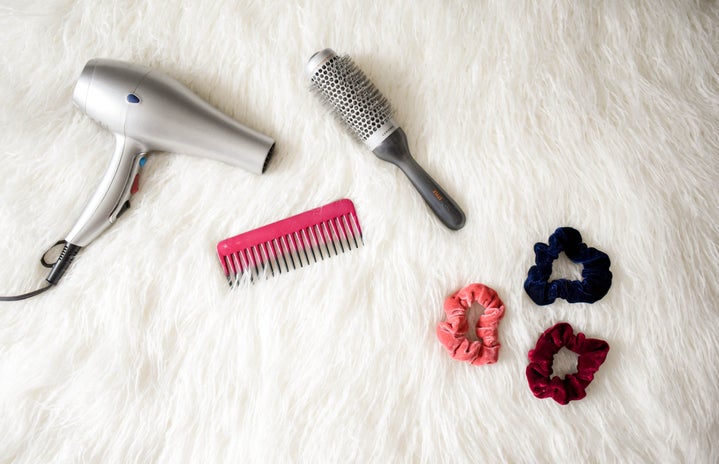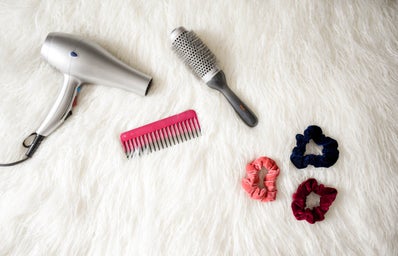Pixie cuts are in, they said. You’ll look amazing with a bob, they said. And maybe you did rock that pixie cut, or maybe that bob framed your face perfectly, but whatever the story, it’s time for something new, and now you’re left to deal with the dreaded growing-out period. What’s are you to do?
First and foremost, we feel your pain. Anytime you try a trend, you risk facing the consequences once you’re sick of it, and some changes take longer than others—growing out your hair being one of them. But don’t fret! We’re here to hold your hand as you transition from pixie to bob and bob to lob—all you need is some creativity and an open mind. With these tips, your shift will be as seamless as possible. It won’t be that bad, we promise.
Slick back your strands
The easiest way to control those short strands? Slick them back! Tons of celebrities have rocked the slicked-back look, from Hayden Panettiere to Alicia Keys, so if you’re looking for inspiration, be sure to check out their takes on the ‘do. Once you’re thoroughly inspired, just grab some gel and go.
Stock up on headbands
If you aren’t a fan of gel, hair accessories can also give a clean, tamed look to those uneven strands. We love the idea of trying out a baby bun and hiding all of the strands that can’t reach by tucking them into a wide headband. So creative and totally sneaky!
Modify your up-do
Thought you couldn’t follow the trends during the awkward grow-out stage? Think again! Top knots are totally in and definitely doable for short-haired gals. They’re the perfect way to pull back strands that aren’t at equal length with the rest of your cut, and if you don’t have enough hair yet for a full knot, you can opt for a baby ponytail—how adorable! A half-up look will keep hair out of your face, making your transition so much less annoying.
Go braid-crazy
You can achieve anything with patience and some bobby pins. Luckily, short hair that can’t make an up-do can still handle some braiding and twisting. And because these sorts of looks are purposely messy, your choppy hair is the perfect template.
Try something textured
Styling can help you achieve the desired length without a cut. For example, if your hair is too long for a normal bob but not yet long enough to pull off the chic lob, bring out your curling iron (or allow your natural waves to flow). The wavier your hair, the shorter it looks, so you can personalize your curl for a length that’s just right. Even better, the opposite is also true! If your natural, wavy hair is just too short for a look, straighten it to get that extra inch you need.
Go blunt or go home
It’s important to ease into a blunt cut when growing out short hair because if you maintain layers, they’ll add too much volume once your locks get longer. This volume can make hair look poofy, which won’t be flattering at chin-length or higher.
Opt for the ombre look
Blunt hair can have a harsh edge that cuts off your face in weird places when growing out. To avoid a boxy shape, try an ombre look! The gradual fade can make those edges look less sharp and more layered, framing your face in ways a single shade can’t.
Start with the front
If you’re starting from a pixie cut, stylists all seem to agree that growing out the front first while keeping the back trimmed is the best way to transition. Why? A longer front and shorter back are easiest to style. You can let your front go completely natural and gel it into place, giving you a rocker-chic look. Or, you can keep your strands pin-straight and let the front become temporary bangs, which you can side-sweep and tuck behind the ear for a classy style. Finally, a longer front can help you transition into an androgynous, shaggy style that’s common on global runways. Who doesn’t want to look like they walked off a Vogue cover?
Give in to extensions
Of course, if you can’t stand to bear the growing out phase, you don’t have to at all. Follow J. Law’s lead and get some extensions. They can fill your hair out where it’s lacking strands, can even up the cut, and can obviously add length. We recommend starting subtle, adding just enough extensions to appear natural and keeping them short enough that your head doesn’t look like it sprouted foot-long strands overnight.
Our last word of advice? Keep tabs on your ‘do! No matter what transition style you choose, it’s always important to make frequent visits to your hairstylist. Because hair grows fast and reaches different stages quickly, consulting a professional to keep your locks trimmed and monitored will ensure as little awkwardness as possible. After all, it’s important to keep your strands looking neat and deliberately styled—if you keep your chin up and act like your hair is exactly how you wanted it, you’ll be totally believable and pull any look off.


